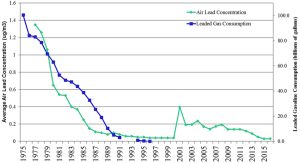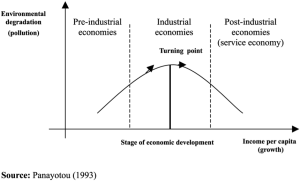12 Lead
scaglion
Lead: A Public Health Success?
Lead pollution is also closely tied to human health and fossil fuel usage but is something of the golden success story in relation to toxic heavy metal exposure worldwide. Throughout the first half of the twentieth century, lead saw widespread usage in commercial and industrial products, most notably as an additive in lead paint and gasoline.25 In the United States, lead-based paint was banned for use in households, children’s toys, and household furniture in 1978,25 and leaded gasoline was gradually phased out beginning with the inception of the Clean Air Act in 1970.25-27 (AS)
The administrator of the United States Environmental Protection Agency summarized it best: “the elimination of lead from gas is one of the environmental achievements of all time… thousands of tons of lead have been removed from the air, and blood levels of lead in our children are down 70 percent. This means millions of children will be spared the painful consequences of lead poisoning, such as permanent nerve damage, anemia, or mental retardation.”27 (AS)
Health Effects and Exposure

53
Lead affects brain development in children and can result in decreased IQ, behavioral, speech, hearing, and overall development problems.53 (AS)
Lead poisoning is especially dangerous for children under the age of five and is a potent neurotoxin that alters the development and function of children’s growing brains.25,29-30 Lead also bioaccumulates, meaning that exposures over time compound to higher levels of overall poisoning and result in more extreme negative health outcomes.29-30 (AS)
In the United States, the most common exposure route for lead poisoning in young children is through the consumption of chips of flaking lead paint or contaminated dust in household environments and is much more common in older (pre-1970s) households and in old households undergoing renovations.25 In developing countries around the world, children are most exposed to lead via contaminated air, water, and soil, because of weaker regulations regarding industrial waste and pollution.25,30 The main environmental contamination routes for lead are manufacturing, mining, and smelting, and children who live near these sites or have parents who work in related occupations are of the highest risk in developing countries, although contamination is essentially widespread.30 (AS)
Developed Countries Move Away From Lead
Environmental contamination of lead peaked in the mid twentieth century and has been declining since.25 Scientific consensus regarding lead’s detrimental effects on human health was established as early as the 1950s, and political bureaucracy in the United States eventually caught up with the science in the 1960s and 1970s, culminating in the inception of the Clean Air Act and creation of the Environmental Protection Agency in 1970.25-29 The Clean Air Act identified criterion air pollutants for regulation in the United States, which included lead, but also importantly included nitrogen oxides and carbon monoxide.26-27 The EPA first introduced reduction standards for lead in gasoline in 1973, but the 1975 introduction of the catalytic converter to address nitrogen oxide(s) and carbon monoxide pollution dramatically reduced the usage of leaded gasoline, as lead destroys catalytic converters.26-27 For this reason, all cars model year 1975 or later in the United States were banned from using leaded gasoline.27 (AS)
 54
54
Six criteria air pollutants were identified by the EPA upon conception of the Clean Air Act. While this included lead, the inclusion of nitrogen oxides and carbon monoxide for regulation largely impacted the move towards lead-free gasoline. (AS)
By 1995, only 0.6% of all gasoline sales in the U.S. were of leaded gas, and by 1996, the Clean Air Act was amended to completely ban leaded gasoline for all on-road vehicles.27 The recognition of the detrimental public health effects of lead exposure and related rising public concern that coincided and followed this era led to the additional banning of lead-based paint usage for households and household furniture as well as children’s toys.25 (AS)

52
Declining leaded gasoline consumption in the 1970s through the 1990s correlates with a similar decline in atmospheric lead levels in the United States. (AS)
Developing Countries Initially Lag Behind, Find Success in 21st Century
While lead usage in gasoline and consumer products was phased out through the latter half of the twentieth century in the United States and other developed countries, developing countries continued to utilize lead additives for decades.28 In 2002, the United Nations Environment Programme formed the Partnership for Clean Fuels and Vehicles to help address this disparity. UNEP found that in 2002, 117 countries around the world still used leaded gasoline, including every country in Africa, where UNEP-funded blood testing of children found dangerously high levels of lead in the blood of children at sites tested in Ghana and Kenya.28 (AS)
The Partnership for Clean Fuels and Vehicles created a campaign to get Africa off leaded gasoline, utilizing methods of lobbying governments and local fuel producers and public programming to debunk unfounded ideas about unleaded gasoline.28 By 2006, all of Sub-Saharan Africa was leaded-gasoline free, and continuous slow victories continued until the world was leaded-gasoline free in every country besides Algeria in 2020.28 Algeria, the last country in the world to sell leaded-gasoline for on road vehicles, announced they had completed their phase-out on August 30th of 2021 – the first time since 1920 that the world has no leaded-gasoline driven cars.28 (AS)
A study sponsored by UNEP and conducted by California State University surmised that leaded-fuel bans save more than 1.2 million lives globally every year, avoid $2.4 trillion in health care expenses, and because lead exposure in childhood often results in behavioral problems in adulthood, prevents over 58 million crimes annually.28 (AS)
Continuing Inequity & Call to Action
The banning of lead additives in gasoline and most consumer products worldwide has been an undoubtedly massive, essential success for global public health. Despite these impressive measures, lead poisoning continues to be a prevalent issue globally. In 2020, UNICEF (United Nations International Children’s Emergency Fund) USA partnered with charity non-governmental organization Pure Earth to report that 1 in 3 children worldwide have lead poisoning30, where the prevalence is particularly acute in low-income countries due to a lack of regulation and enforcement regarding industrial waste and pollution. This 1 in 3 ratio equals about 800 million children up to age 19, with UNICEF reporting that nearly half of those 800 million children live in South Asia.30 (AS)

32
Environmental Kuznets Curve showing the relationship between stage of economic development and environmental degradation. Developing countries that are continuing to industrialize are nearing the peak of environmental degradation and pollution. Should industrialized countries help developing countries industrialize in a cleaner way?32(AS)
Many South Asian countries, along with other developing countries in the world, are still going through the heavily polluting era of industrialization. The Environmental Kuznets Curve31 helps represent this idea of environmental degradation tied to economic growth: increased manufacturing increases economic growth, but also degrades the environment as industrialization outpaces environmental management guidelines. Massive productivity increases are essential for economic growth and country development, yet increases in industrial manufacturing, mining, smelting, and a population shift towards developing city centers create many new pollution issues. The Kuznets Curve also helps represent post-industrialization’s beneficial impact on the environment, as city centers continue to develop upgraded infrastructure, economic stability leads to impressive impacts on quality of life, and populations start to expect higher standards of living (and environmental viability). (AS)
As developing countries of today continue to undergo this process of industrialization, one argument in favor of environmental protection is that countries that are already in the developed post-industrial stage should use their economic and technological resources to help developing countries industrialize in a more sustainable, Earth-friendly manner. Until this is done, developing countries will continue to suffer the consequences of lead and other toxic pollution. (AS)
